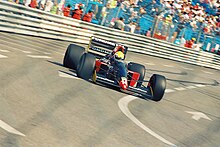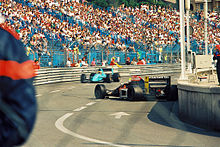Fondmetal Fomet 1
The Fondmetal Fomet 1 was a Formula 1 car from the Italian racing team Fondmetal Corse , which was used in the 1991 Formula 1 season . In the following year , the team launched the technically hardly changed car under the name Fondmetal GR01 .
Fomet
The Fomet 1 was designed by Fomet employees in the UK during the early months of 1991 . The engineers in charge were Tino Belli and Tim Holloway , some detailed work was later done by Richard Divila .
Fomet was initially closely associated with the Fondmetal Corse racing team. Fondmetal, an Italian rim manufacturer owned by Gabriele Rumi , had been a long-term sponsor of the Turin racing team Osella in the 1980s . At the end of 1990, Fondmetal took over the financially and technically troubled team, and since then Gabriele Rumi has endeavored to professionalize the technical basis of the team.
At the beginning of the new naturally aspirated engine era, there was a general belief that Great Britain had the best motorsport engineers and the greatest density of suppliers. This led to the belief that the best Formula 1 cars were built there. In view of this, many continental European Formula 1 teams set up branches in Great Britain, where at least part of the car development took place. This was true for top teams like Scuderia Ferrari as well as for small teams. Fondmetal also followed this development: At the end of 1990, Gabriele Rumi founded the company Fomet in Bicester , which was mostly staffed by British engineers. Fomet was housed on the March Engineering premises and was initially looked after by former March engineer Robin Herd . During this time the Fomet 1 was created.
After only a year there was a break between Fomet and Fondmetal. Fomet began doing work for other teams in late 1991. Rumi refused to expand its activities and terminated its collaboration with Fomet, although the development of the Fondmetal car for the 1992 season had already started there. Fomet continued the development work on the car alone and finally sold the construction to the French team Larrousse , which used it in 1992 under the name Venturi LC92 . Fondmetal commissioned another company to design its 1992 car. The realization of the new vehicle called GR02 was delayed until spring 1992 due to the reorientation.
technology
The Fomet 1 is mostly described in the literature as a simple, uncomplicated car that still had some of the features of the last Osella design from 1989. The aerodynamics had been redeveloped, and the monocoque was also narrower than its predecessor. The suspension was conservative and consisted of push rods all around. An eight-cylinder Cosworth engine served as the drive . Fondmetal took over some of the engines prepared by Hart Racing Engines that had been used by Tyrrell in the successful 019 the year before . The power transmission took place via a six-speed gearbox developed by Fondmetal, which - unlike in the predecessor - was installed transversely.
The drive technology was replaced for the 1992 season. Instead of last year's Cosworth DFR engine, the GR01 used an eight-cylinder engine from the HB series . These were the 5th generation engines ("HB V") that had been used by Benetton in 1991 . Some sources put its power at 645 hp, others put it at 730 hp.
Fondmetal manufactured two Fomet 1 chassis for the 1991 season.
1991 season
At the beginning of the 1991 season, the designers and mechanics had not yet completed the Fomet 1. The team contested the first two races with the Osella FA1ME model , which was taken over by Osella , which is now entering its third season.
The Fomet 1 debuted at the first European race, the 1991 San Marino Grand Prix . At this point it was not yet fully developed. Before the race weekend there had only been a brief functional test; detailed coordination work had not yet taken place. A few more test drives followed during the season. You and the work of Richard Divila, who had joined the team in the spring of 1991 as technical director, helped to gradually improve the car's lack of reliability.
In 1991, Fondmetal only reported one driver. Initially, Olivier Grouillard drove for the team; for the last three races of the year he was replaced by Gabriele Tarquini . Fondmetal was unsuccessful with the Fomet 1 in 1991. In 14 attempts, the team was only able to qualify six times; It was eliminated seven times in the pre-qualification. There were only three finishings in the whole year. The best result was Grouillard's tenth place at the 1991 Belgian Grand Prix .
1992 season
Due to the break with Fomet, the development of the car for the 1992 season was delayed significantly. Contrary to what was planned, Fondmetal therefore had to start the new season with last year's car. In order to document the separation from Fomet to the outside world, the Fomet 1 was given a new name for 1992: It was called GR01 in the future. The name took up the initials of the team owner Gabriele Rumi. Technically, the GR01 corresponded completely to the Fomet 1. The change from DFR to HB motors made some changes in the motor environment necessary.
In 1992, Fondmetal used two cars. The drivers were Gabriele Tarquini and Andrea Chiesa . Tarquini drove the GR01 up to the Monaco Grand Prix . In these four races he was able to qualify regularly, but retired early. Then Tarquini used the new GR02.
Chiesa drove the GR01 up to the Grand Prix of Great Britain . He had received a GR02 at the race in France a week earlier ; however, he damaged the newly built car so badly in a start-up accident that it took until the race at the Hockenheimring before the new car was restored. Chiesa never finished in 1992.
Race results
1991: Fondmetal Fomet 1-Cosworth DFR V8
| driver | No. | 1 | 2 | 3 | 4th | 5 | 6th | 7th | 8th | 9 | 10 | 11 | 12 | 13 | 14th | 15th | 16 | Points | rank |
|---|---|---|---|---|---|---|---|---|---|---|---|---|---|---|---|---|---|---|---|
| 1991 Formula 1 season |
|
|
|
|
|
|
|
|
|
|
|
|
|
|
|
|
0 | - | |
|
|
14th | DNPQ | DNPQ | DNPQ | DNF | DNF | DNPQ | DNPQ | DNQ | 10 | DNF | DNPQ | |||||||
|
|
12 | 11 | DNPQ | ||||||||||||||||
1992: Fondmetal GR01-Ford Cosworth HB V8
| driver | No. | 1 | 2 | 3 | 4th | 5 | 6th | 7th | 8th | 9 | 10 | 11 | 12 | 13 | 14th | 15th | 16 | Points | rank |
|---|---|---|---|---|---|---|---|---|---|---|---|---|---|---|---|---|---|---|---|
| 1992 Formula 1 season |
|
|
|
|
|
|
|
|
|
|
|
|
|
|
|
|
0 | - | |
|
|
14th | DNQ | DNF | DNQ | DNF | DNQ | DNQ | DNQ | DNF | ||||||||||
|
|
15th | DNF | DNF | DNF | DNF | ||||||||||||||
| Legend | ||
|---|---|---|
| colour | abbreviation | meaning |
| gold | - | victory |
| silver | - | 2nd place |
| bronze | - | 3rd place |
| green | - | Placement in the points |
| blue | - | Classified outside the point ranks |
| violet | DNF | Race not finished (did not finish) |
| NC | not classified | |
| red | DNQ | did not qualify |
| DNPQ | failed in pre-qualification (did not pre-qualify) | |
| black | DSQ | disqualified |
| White | DNS | not at the start (did not start) |
| WD | withdrawn | |
| Light Blue | PO | only participated in the training (practiced only) |
| TD | Friday test driver | |
| without | DNP | did not participate in the training (did not practice) |
| INJ | injured or sick | |
| EX | excluded | |
| DNA | did not arrive | |
| C. | Race canceled | |
| no participation in the World Cup | ||
| other | P / bold | Pole position |
| SR / italic | Fastest race lap | |
| * | not at the finish, but counted due to the distance covered |
|
| () | Streak results | |
| underlined | Leader in the overall standings | |
literature
- Alan Henry: Autocourse 1992/93 , London 1992 (Hazleton Securities Ltd.), ISBN 0-905138-96-1 .
- Patrice Buchkalter and Jean Francois Galeron: Formula 1 - a complete guide to 1992 , Surrèsnes (Taillandrier) 1992, ISBN 2-87636-107-8 .
- Adriano Cimarosti: The Century of Racing. Cars, tracks and pilots. Motorbuch-Verlag, Stuttgart 1997, ISBN 3-613-01848-9 .
- David Hodges: A – Z of Grand Prix Cars. Crowood Press, Marlborough 2001, ISBN 1-86126-339-2 (English).
- David Hodges: Racing Cars from A – Z after 1945. Motorbuch-Verlag, Stuttgart 1994, ISBN 3-613-01477-7 , p. 116.
- Pierre Ménard: La Grande Encyclopédie de la Formule 1st 2nd edition. Chronosports, St. Sulpice 2000, ISBN 2-940125-45-7 (French).
Web links
Individual evidence
- ^ History of the team on the website www.f1rejects.com ( Memento from December 27, 2010 in the Internet Archive ) (accessed on January 10, 2011).
- ↑ Cf. on this: Cimarosti. The century of racing. P. 374.
- ^ Ferrari founded a branch in Guiltford, in which the complete chassis of the 1989 model F1-89 was created (cf. Cimarosti: Das Jahrhundert des Rennsports, S: 401); EuroBrun Racing established Brun Technics in Basingstoke.
- ↑ a b Ménard: La Grande Encyclopédie de la Formule 1, p. 463.
- ^ Hodges: AZ of Grand Prix Cars 1906-2001, p. 102: "a straightforward car".
- ↑ a b Auto Course 1992/93, p. 63.
- ↑ Cimarosti: The Century of Racing, p. 433.
- ↑ Cimarosti: The Century of Racing. P. 443.

